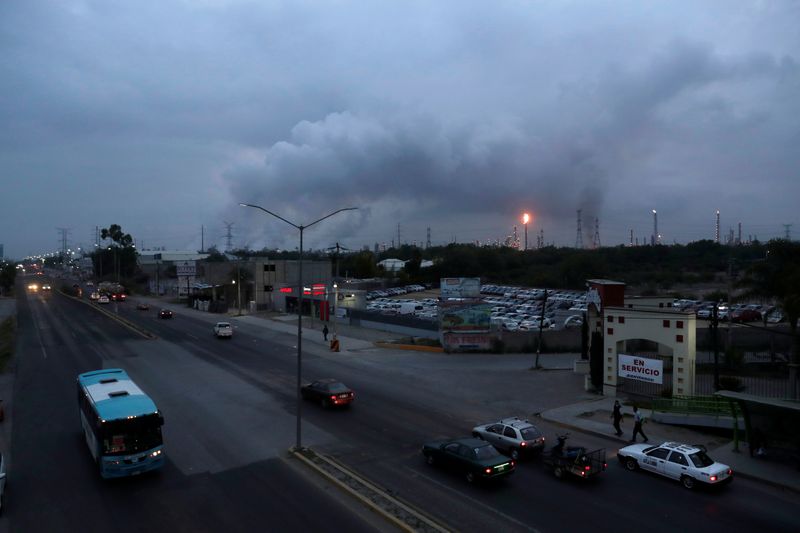This post was originally published on this site
https://i-invdn-com.akamaized.net/trkd-images/LYNXNPEG740QA_L.jpg
TULA, Mexico (Reuters) – For at least four years, one of Mexico’s largest power plants violated an environmental safeguard that prevents emissions of deadly pollutants, according to documents seen by Reuters.
The Tula thermoelectric plant north of Mexico City breached the legal limit for the amount of sulfur in the fuel oil it burned between 2016 and 2019, according to internal documents from the national electricity company, Comision Federal de Electricidad (CFE), which owns and operates the plant.
The sulfur content during each of those four years – detailed in state-run CFE’s annual operations reports – was at least 3.9%, nearly double the 2% cap set by Mexico’s energy regulatory commission for six industrial corridors, including the Tula area.
While some Mexican environmentalists have long believed that the plant was breaking the sulfur content rules, the CFE’s reports on plant operations that were seen by Reuters detail the violations. The reports are not publicly available.
Reuters could not determine whether the power plant has continued to use fuel oil containing excess sulfur this year.
Besides the high sulfur levels, the CFE documents show another violation: emissions of sulfur dioxide, a harmful air pollutant, are not being registered by the plant even though that is required by law.
“The CFE shouldn’t burn this fuel at 4%. The rule establishes that it should be at 2%,” said Xochitl Galvez, who grew up near the Tula plant and is now a senator for the opposition National Action Party.
The CFE did not respond to repeated requests for comment. The energy regulatory commission, which is meant to enforce the sulfur limits, also did not respond to questions.
Mexican law sets fines of between $82,000-$820,000 for breaches of contaminant limits for fuels, including the maximum sulfur content allowed.
When high-sulfur fuel oil is burned without contaminant-capturing filters, massive amounts of particles and gases are released into the air that some scientific studies show can lead to premature death and more people developing respiratory diseases like chronic bronchitis as well as some cancers.
Energy experts say the plant is likely operating with few or no filters. Reuters could not independently confirm this.
The CFE did not respond to questions about premature deaths or whether the plant uses filters.
“They must not have hardly any controls on their stacks,” said Jonathan Dorn, an emissions expert at U.S.-based consultancy Abt Associates, who works closely with the U.S. Environmental Protection Agency’s power plant monitoring.
He described the Tula plant’s 2019 emissions levels as “crazy.”
The Tula plant’s five chimneys belch out a steady stream of purplish-gray smoke at all hours, easily visible from its perimeter fence. An acrid smell fills the air, causing mild throat irritation. Next door lies Mexican state oil company Pemex’s second-largest refinery, where the fuel oil is produced.
High sulfur fuel oil is produced by Mexico’s refineries for a number of uses besides power generation.
Pemex’s press office did not respond to requests for comment.
CAPITAL SMOG
Some environmentalists and academics have linked emissions from the Tula plant to chronic poor air quality in Mexico City 58 miles (94 km) away where a frequent haze has not abated during the coronavirus lockdown despite sharply reduced traffic.
The violations at the CFE’s 1,500 megawatt power plant, one of the three biggest in Mexico, mostly predate President Andres Manuel Lopez Obrador.
Opposition politician Galvez, along with environmental scientists who have studied the Tula plant, said the continued violations during 2019 reflected an ongoing dependence on fossil fuels in Lopez Obrador’s first year in government.
About 13% of Mexico’s power comes from renewable sources, mostly wind and solar, according to energy ministry data.
Lopez Obrador’s office did not respond to a request for comment.
In the past the president has said he cares about a clean environment, while being unapologetic about the need to prioritize domestic supplies as he seeks to wean the country off foreign fuel imports.
His national energy plan, unveiled in June, called for “making the most of fuel oil for electrical generation” while taking unspecified steps to lower sulfur levels.
CFE chief Manuel Bartlett told Reuters in a May interview that the company is committed to using cleaner energy, especially natural gas, but that such a transition will take time. The CFE is also looking to expand hyodroelectricity generation.”We want to eliminate fuel oil, but you can’t do that from one day to the next,” Bartlett said.
High levels of sulfur in oil burned for power create three especially dangerous air pollutants: sulfur dioxide, nitrogen oxides and particulate matter smaller than 2.5 microns (PM2.5).
The CFE documents show that the Tula plant emitted 9,487 tonnes of PM2.5 in 2019. That made it the highest emitter in North America, according to a Reuters comparison with publicly-available U.S. and Canadian government data. The coal-fired Shawnee power plant in Kentucky was the top U.S. emitter, the comparison showed.
Tula’s PM2.5 emissions exceeded Shawnee’s by nearly 30%.
The Tennessee Valley Authority, a U.S. state-owned enterprise that operates the Shawnee plant, did not respond to a request for comment.
Tula emitted 14,090 tonnes of nitrogen oxides last year, the documents showed, putting it in third place for the largest emissions of those contaminants in North America.
Following years of public pressure in Mexico, the Tula plant was upgraded from 2009-2016 to also use cleaner-burning natural gas.
However, a natural gas pipeline that would supply Tula has stalled since 2015. Nearly all of the plant’s power in 2019 came from burning 8.6 million barrels of fuel oil, the CFE documents show.

